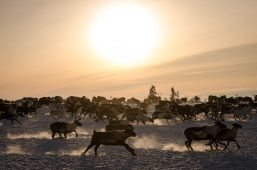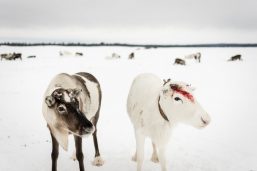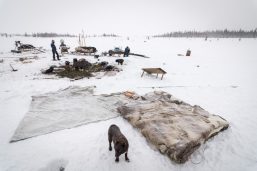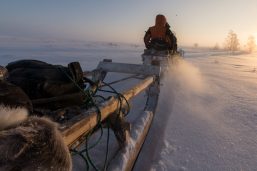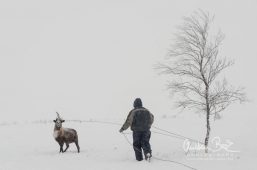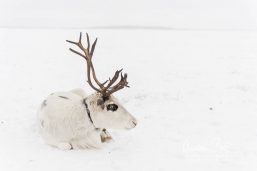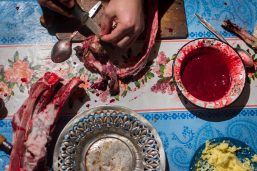It was long since a dream of mine to spend time with reindeer-nomads in the arctic winter. In January 2016, after a long research and building connections, this became true – mostly thanks to my friend Maria from St. Petersburg. We were able to organize a stay for a whole month together with a family of the Nenet ethnicity and their thousands of reindeer in the tundra of the NAO district (Nenet Autonomous Region), situated at the Barents Sea, still west of the Ural Mountains. With my friend Nanda joining as a photographer (phocus.com.sg) and Maria as a translator, we were living and working for four weeks together with the nomads.
Moving south
With the reindeer being their major source of food, clothing and even housing since hundreds of years, the Nenet people follow and partly direct their yearly journey between the open tundra in the north and the endless forests of the taiga in the south. This natural cycle follows the pressure of the environmental conditions, since the animals need a place rich in food when the calves are born in May whereas the open tundra is their natural habitat in summer. Some subspecies of reindeer are sedentary, the migration distances can vary widely, from thousands of kilometers in case of the caribous in Northern America to about 200-400km in the Russian tundra. This time of the year the Nenet people move every two weeks to catch up with their major herd. Approaching the time of calving, this interval narrows down to about 2-3 days, because they have to reach the calving-grounds in time and stay close to the animals and guard the process. Separate to the main herd of thousands of deer they keep about 70-100 individuals as draft-animals, which have been tamed and prepared to tow their sledges when moving.
This strong bond with the nomadic behavior of the animals leans towards a more integral perspective about the place of humans in the ecosystem of the planet. It’s a luxury of our times that through technological advancement a minority of people can afford the perception of being more or less independent from the natural cycles and growing largely emotionally disattached from direct environmental pressures. Which on one hand of course might be relieving, on the big scale though it is an illusion. In respect to the global human-induced ecological catastrophe, one of the greatest challenges we face is to create a more holistic world-picture rather than an atomic, individualistic and independent viewpoint. From a larger perspective this simply does not reflect reality and is counterproductive in dealing with the global problems of our century.
Management of the herd
The lasso is the tool of choice for the herds’ management. The animals have to be caught for various reasons, be it vaccinations, castrations, picking future draft-bulls for taming and training, separations after mixing with other herds or caring about the healthy development and harvest of antlers, which are sold for pharmaceutical/cosmetic purposes. The catching-process is an art in its own right with a team of at least 2 people involved. It requires a lot of training in handling the rope as well as experience in evaluating the dynamics of the herd and quickly recognizing the animals in question as they gallop apart. Reindeer are very powerful, but compared to horses or yaks they average a similar level of strength as a grown-up healthy man. Once caught with the lasso, the catcher is holding the rope while the other person is approaching the deer and fighting it to the ground, if possible usually gripping the antlers and sitting on the back to force it to hold the position. The older bulls often need more people to be successful.
The feeling you gather when dealing with the deer is a very powerful experience. The soft, pleasant touch and smell of the thick healthy fur creates an immediate attraction, be it when stroking and handfeeding the tamed individuals in the draft-herd near the camp or while catching and handling the wilder deer out in the tundra. I guess that this fascination partly originates from reindeer being some sort of emblem for the wilderness, although even the animals of the main herd are in respect to humans long since not behaving any more like actual wild deer are. Nevertheless dealing with them triggers some sort of archaic feelings, as if you rediscover what people once were actually supposed to do – being out there in the woods, in constant physical movement and in close contact with their fellow creatures. Taking in consideration our evolution and the fact that genetically we actually didn’t change a lot in the last 50 000 years, let alone during the dramatic shifts in life-style of the last 200 years – this seems to be not far off the truth. At least it’s pretty clear that our physiology is not built to sit and stare into a screen day in and day out.
Slaughtering and meat consumption
Deer is chosen for slaughter in respect to age, sex and sometimes even behavior. Cases occur when the mother abandons their youngsters, which then have to find another family. These females sometimes can be recognized by having very shabby antlers, because they allow other deer to chew on them as a source of minerals. It’s a symptom of a lazy and passive attitude, which is not an optimal character for bringing up and protecting ones’ offspring.
Although nowadays the Nenet people in this region are leading quite a modern life, partly driving with snow-mobiles and watching TV via satellite-dishes, some old traditions are still in place. This is also true for the slaughtering process. After killing (which is carried out by stabbing into the neck), the head of the reindeer is supposed to always point towards the east with the animal laying on its right shoulder. During the disembowelment, the spleen is splashed against the left shoulder and remains there for the whole process as an omen for good luck. As far as possible, the blood is left in the torso after the intestines have been taken out. A twig is put between the rips and the abdomen wall in order to seal it for the transportation, where the neck must always point towards the end of the sledge. Back at the camp the blood will be scooped out of the abdominal cavity into a jug so later it can be used as a dip or sauce.
The Nenet people eat a lot of the reindeer meat raw and drink the blood. Due to the environmental conditions, growing crops is obviously not an option in this latitudes. Fresh reindeer-meat and blood though is very rich in vitamins and nutrients, which would be destroyed by cooking or frying. For most members of our culture this seems to be absolutely disgusting. Of course they make sure that the deer is healthy and check concerning parasites during the slaughtering process, but it’s clear that they’d never send it to a lab and check if it’s ok before consumption. In rare cases this could be lethal though, if you overlook an animal with an infestation of trichina worms for example. The trust they have into the health of their animals and the ecosystem since ages is admirable, and something that seems to be crazy when you grew up in a place where all food is checked in laboratories.

